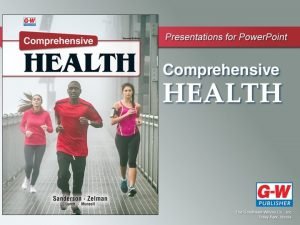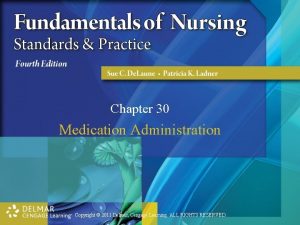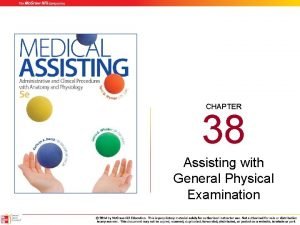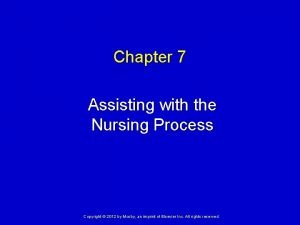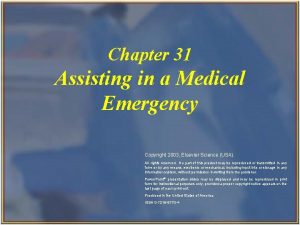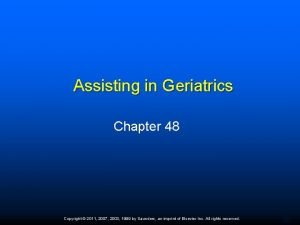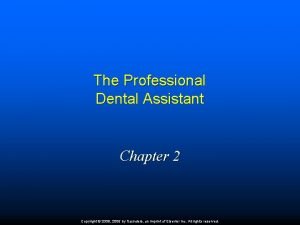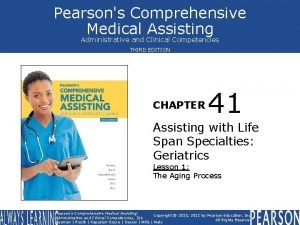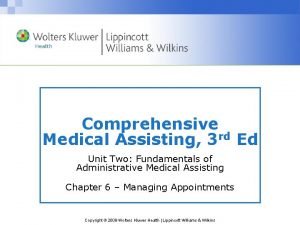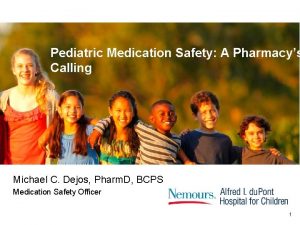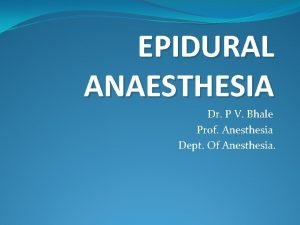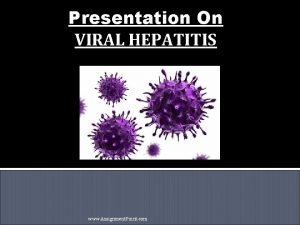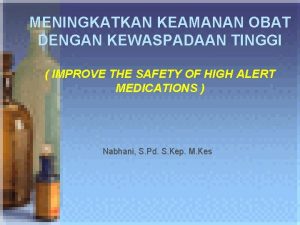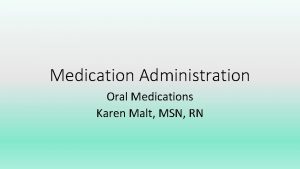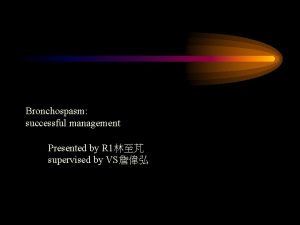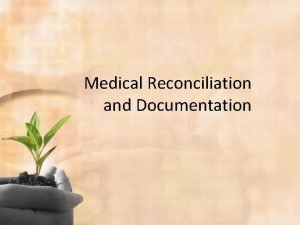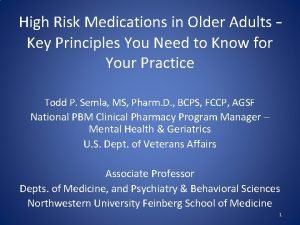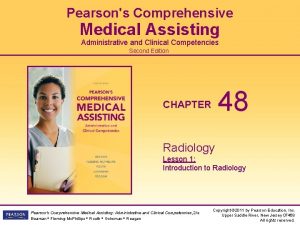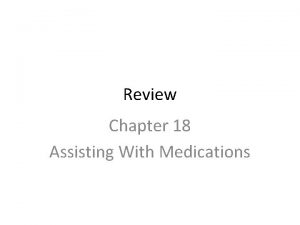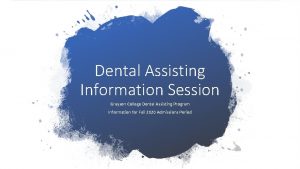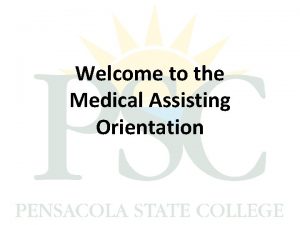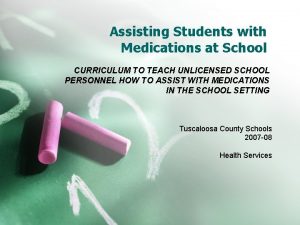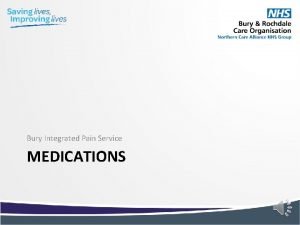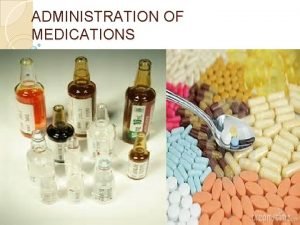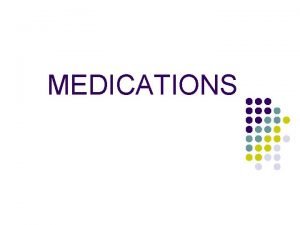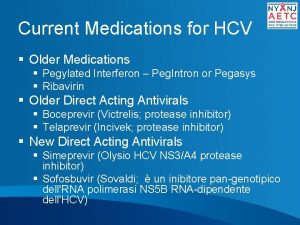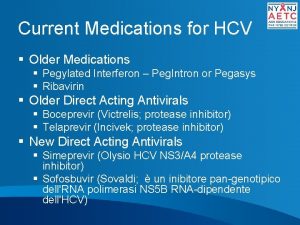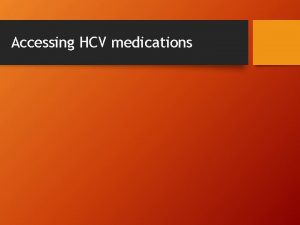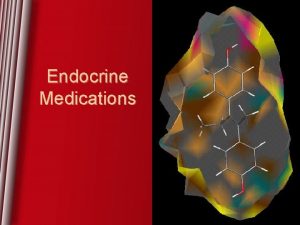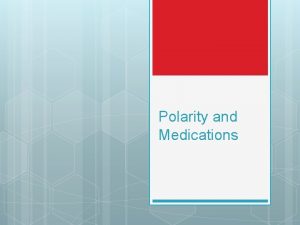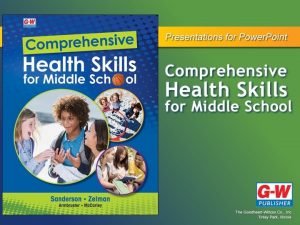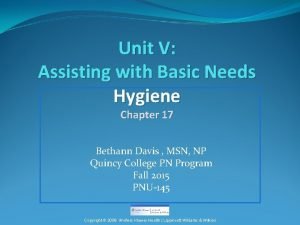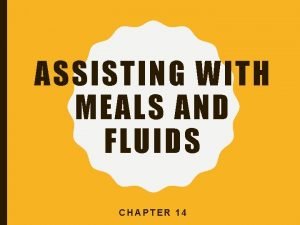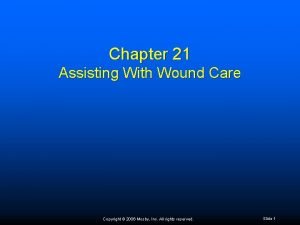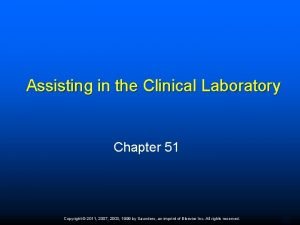Chapter 18 Assisting With Medications Assisting With Medications



















































- Slides: 51

Chapter 18 Assisting With Medications

Assisting With Medications • Administering medications is one of the most sensitive and important duties that the medical assistant will perform • You must become familiar with the medications that are most frequently given to the patients treated in your office

Commonly Prescribed Medications • Depending on the type of medical practice, certain medications will be more commonly prescribed than others • The entire staff should become knowledgeable about all medication used in their practice • The list on page 902 Table 18 -1(34, anti, sedatives, laxatives ect. . ) are commonly used drugs

Commonly Used Drugs • Anticoagulant: Prevents or delays or slows blood clotting(Heparin, Coumadin) • Antipyretics: Reduces fever(Tylenol, Aspirin) • Sedative: Produces a calming effect without causing sleep(Phenobarbital) • Antihistamines: Acts to counteract histamine(allergies/cold) Benadryl • Antitussives: Prevents or relives cough(Codeine) • Antibiotic: Is destructive to or inhibits growth of microorganisms(fights bacterial infection) Penicillin, Augmentin • Analgesics: Relives pain(Acetaminophen, Ibuprofen) • Anticonvulsant: Prevents convulsions(Dilantin) • Hypoglycemic: Lowers blood glucose level(Insulin)

Pharmaceutical References • The Physicians’ Desk Reference(PDR) • The PDR is one valuable resource that the medical assistant should keep handy in the medical office • The purpose of the PDR is to provide accurate, reliable, and current information about the most prescribed medications and related products • You may need to consult the PDR for the proper spelling, strength, or any other information concerning medication • Read pages 903 -904

Guidelines For Using The PDR • Pink section: is the brand(and/or generic) name of the drug in alphabetical order • Blue section: Classification of the drug(Ex: narcotics, antifungal) • White section: Manufacture Index(Smith-Kline Pharmaceuticals: makes paxil)

Drug Categories And Classifications • Drugs are classified into different categories or groups: • Those that prevent disease(vaccines or immunizations) • Those that have a particular action on the body(analgesic/ helps with pain) • Those that have a target effect on organs and body systems(cardiac drugs) • How are they prepared(liquid, suppository, tablet. ect. . )

Drug Categories And Classifications • Medications will often have more than one name: • A generic name: Are copies of brand-name drugs that have exactly the same dosage, intended use, effects, side effects, route of administration, risks, safety, and strength as the original drug. In other words, their pharmacological effects are exactly the same as those of their brand-name counterparts(ex: acetaminophen) • A trade name or brand name: is the name of the manufacturer and ADA gives the medicine(ex: Tylenol) • The brand name is usually written most clearly on any packaging. However, you will always see the generic name written somewhere on the packet (often in small print). Some medicines only have the generic name on the packet. • Generic names tend to be harder to remember than trade names

Drug Categories And Classifications • The trade name is usually capitalized and written bold • The generic name is usually smaller and under the trade name

Drug Forms • Drugs are manufactured in many different forms, including: • Liquid: drug is dissolved or suspended in a solvent(water or alcohol) • Solid: tablets, capsules, caplets, lozenges, suppositories, and ointments • Transdermal: Small adhesive patch is placed directly on the skin • Ocular: Drugs of the eye • Implantable: Positioned beneath the skin(insulin infusion pump, Implanon: birth control)

The Medication Order • Before a prescription is written, a medication order must be given by a physician. • Get clarification on any medication if questionable • A medication order should contain the following information • -Full name of patient • -Name of medication • -Dosage and route of administration • - How often the medication is to be administered • -Date and time order was written • -Any specific directions • -Signature of the prescriber • -DEA (Drug Enforcement Agency number)if needed

Writing Prescriptions • All prescriptions are considered to be a legal document • Most narcotics(pain medication) needs to be pick -up by the patient(cannot be called in) and ID needs be shown to the pharmacy • Most prescriptions are computer-generated and have a tamper-proof watermark • When phoning in prescriptions, you must give the pharmacist all the information the prescription contains

Controlled Substances • All physicians who prescribe, dispense, or administer controlled substances in the United States must register with the United States Department of Justice Drug Enforcement Administration(DEA), under the Controlled Substances Act of 1970 • Registration must be renewed every 3 years • A written, signed prescription must be presented to the pharmacist within 72 hours of time for a controlled substance to be in compliance with Drug Enforcement Administration (DEA) regulations

Controlled Substances(list on page 907) • Controlled substances included “street drug” such as heroin, cocaine, stimulants, depressants, narcotics and any drug derived from them • Controlled substances are categorized into five different schedules, base on their potential for abuse or addiction, as follows: • Schedule 1: These dugs have no recognized medical use in the U. S. and prescriptions for such drugs are prohibited(high risk for abuse)LSD, Heroin • Schedule 2: These drugs must have a written or types prescription, no refill, have DEA number(risk for abuse, may lead to psychological abuse)Morphine • Schedule 3: Prescriptions may be written or phoned, refill up to five times within 6 months(have a potential for abuse but less than 1 and 2)Hydrocodone, Depressants • Schedule 4: Prescriptions may be written or phoned, refill up to five times within 6 months(low potential for abuse)Phenobarbital • Schedule 5: Subject to state and local regulations(Very limited quantities of narcotics and low potential risk for abuse)codeine cough syrup

Recording Medications • Many factors need to be included in recording medication information on the patients chart • The following is a list of the details that should be included in recording medications • -Who: who ordered the medications • -What: what medication was given(including lot # and expiration date) • -When: the date and time the medication is administered(always check expiration date) • -Where: refers to the route(oral, sublingual, ect. . ) • -Why: Answer this question for the patient verbally or by educational material(this may help, if you have made a mistake)

Abbreviations And Metric Measurements • Abbreviations are on page 911(make flashcards) • bid- twice a day, tid- three times a day • Metric measurements are on page 912(make flashcards) • 1 kg = 2. 2 lbs

Storing Medications • The rule is “ a place for everything and everything in its place” • Label shelves • Categorize • Narcotics needs to be locked up • Immunizations need to be refrigerated or frozen • Check and discard properly if outdated • Be familiar with storage of all medications

Administering Medication • There are many methods of medicating patients and even though you may not administer every type, you should know something about each one • The methods of administering medication are: • - sublingual: under the tongue • - buccal: in the cheek • - topical: including sprays • -transdermal: medication is delivered across the skin

Administering Medication • Before you administer the medication, always be sure that you have the right: 1. PATIENT 2. MEDICATION 3. DOSE/AMOUNT 4. ROUTE/METHOD 5. DOUMENTATION 6. TIME/SCHEDULE THESE ARE KNOWN AS THE SIX RIGHTS Following any injection, a patient should wait 20 minutes, in case of an adverse reaction

Medication Errors • If an error is made with a medication, necessary steps must be taken immediately to report it to the doctor so emergency care can be given to the patient if necessary • Some errors may include: - Drug given to wrong patient - Wrong drug given to the correct patient - Incorrect drug dosage administered - Incorrect documentation placed in the patient’s chart - Drug given by the incorrect route - Drug given at the wrong time

Considerations For Medications • Considerations for route of administration may include: - Age of patient: - Physical condition - Body size or mass - Gender Most oral medications are intended for absorption in the small intestine The remaining methods are parenteral, or intended for absorption outside the digestive system(Sub Q, IM, IV)

Routes Of Administration(ORAL) • This is one of the most common methods of administering medication • These medications are in the form of pills, tablets, capsules, caplets, lozenges, syrups, sprays, and other liquids, which are swallowed • Read liquid medication at eye level

Routes Of Administration(Sublingual or Buccal) • The sublingual method involves placing a tiny tablet or spray under the tongue • This introduces the medication immediately into the bloodstream • Medication(spray or tiny tablet) may be introduced in the mouth between the gum and the cheek, this is called buccal

Routes Of Administration(Inhalation) • Medication given by the inhalation method are in the form of gases, sprays, fluids, or powders(mixed with liquid) • These are breathed into the respiratory tract • One form of inhalation is oxygen, and should be in every office for emergency use • Oxygen is used in liters per minute(LPM), and delivered by a nasal cannula or mask

Routes Of Administration(Topical) • Topical medications are sprays, lotions, creams, ointments, paints, salves(aloe vera), wet dressings, and transdermal patches(ex: smoking patches) • With patches the desired amount is released into the patients tissues and into the circulatory system

Injections • Because the method of injections introduces the substance directly into the bloodstream, extreme caution must be practiced • The proper technique must be learned • There is always a possibility of anaphylactic shock • In this event a physician should be notified immediately, and epinephrine should be administered • Vital signs should be monitored until patient is stable

Injections • Syringes commonly used in the medical office include: • 3 m. L syringe • Each small line represents 0. 1 m. L(CC) • Tuberculin syringe, is calibrated in tenths of a milliliter • This syringe has only a 1. 0 -m. L

Part of a syringe flange

Injections(syringe sizes)

Needles • Needles come in a variety of lengths and gauges • When referring to a needle, a gauge describes how wide the diameter of the needle is • Gauge is the outside diameter of a needle • Needle Lengths: 5/8 inch, 1 ½ inch

Parts of a needle

Injections • You need to properly read the amount of medication in the syringe • The plunger of the syringe has a black rubber tip at the end inside the barrel • You read the syringe by reading the calibration mark that lines up with the point on the black rubber tip of the plunger

Withdrawal Medications From A Ampule • Ampule is a small glass vial that is sealed after filling • Flick the pointed end of the ampule(so medication is returned into the ampule) • Disinfect ampule neck with alcohol • Place a sterile gauze over the middle of the ampule • Grasp the tip of the ampule(with gauze) and snap off away from you, discard the tip(sharps only) • Remove liquid medication with a filter needle • Do not touch the rim(may cut you and you must maintain a sterile technique) • Discard the rest of the ampule(sharps only)

Withdrawal Medications From A Vial • • • There are single and multi-vials Removal the needle guard(cap) Alcohol the top of the vial Insert needle into the vial(some medications you will need to add air ex: insulin) Hold the vial upside down with your other hand Plug back on the plunger and withdraw the desired amount(rule: do not re-introduce TB medication back into the vial) Tap syringe lightly to removal air bubbles Withdrawal the needle from the vial and change the needle RULE: NEVER-EVER RECAP A NEDDLE

Reconstitute A Powder Medication • Powder medication must be mixed with a diluent • Use the proper amount of diluent for the medication(read the label carefully) • Insert the diluent into the power medication and gently roll the vial with your hand until thoroughly mixed

Administering Injections Intradermal • Intradermal Injections(ID) • Used in allergy and tuberculin testing • The intradermal injection is administered just under the surface of the skin with a fine gauge needle(23 to 25 gauge, 5/8 inch long) • The angle of the insertion into the skin is 10 to 15 degrees • The bevel of the needle should be up

Administering Injections Intradermal • A small wheal should develop at the site of the injection to give evidence that the medication is in the dermal layer of the skin • Very small amounts of medication(0. 01 to 0. 05 m. L) are administered by this method of injection • A patient will return in 72 hours to have the test read

Subcutaneous Injection or Sub Q • Subcutaneous Injection(sub Q) injections are used to administer small does of medication, usually no more than 2 m. L • The most often site is the upper outer part of the arm • The length of the need ranges from ½ to 5/8 inch and gauge is 25 to 27 G • Sub Q injections are administered at a 45 degree angle(pinch the skin) • Subcutaneous is found above muscle tissue

Intramuscular Injections • Intramuscular Injections(IM) injections are placed into muscle tissue • The most common sites are the deltoid, ventrogluteal(next slide) and vastus lateralis

Ventrogluteal

Intramuscular Injections • The angle for a intramuscular injection is 90 degrees • Dosage may range from 0. 5 m. L to 3 m. L • The gauge is between 18 to 23 G the length depends on the size of the patient and injection site

Aspirating Medications • An intramuscular injection is an injection given directly into the central area of a specific muscle. • In this way, the blood vessels supplying that muscle distribute the injected medication via the cardiovascular system • Aspirate at the injection site (while syringe and needle are within the muscle) by holding the barrel of the syringe with the nondominant hand pulling back on the syringe plunger with the dominant hand. If blood appears in the syringe, it is an indication that a blood vessel may have been punctured. The needle and syringe should be immediately withdrawn and a new injection prepared. If no blood is aspirated, continue by slowly injecting the medication at a constant rate until all medication has been delivered.

Aspirating Medications • Aspiration is not indicated for SC or IM injections of vaccines(immunizations)because there are no large blood vessels in the VL • Aspiration may be indicated for some IM injections including antibiotics, pain medications ect, Ventrogluteal because of the large amount of blood vessel • This is a 2011 study from the CDC

Types Of Vaccines

Immunization Schedule • When more than one dose of a vaccine against a particular disease, such as the Dtap injections, is referred to as a primary “series” • Each of these should be given with at least 6 to 8 weeks between each dose • The primary series requires a booster for the immunizations to most effective and complete

Disease Protection • Influenza: commonly referred to as the flu, is an infectious disease • Typically, influenza is transmitted through the air by coughs or sneezes • Typically, this vaccine includes material from two influenza A virus(including H 1 N 1 -swine flu)subtypes and one influenza B virus strain • Pneumonia: is a breathing (respiratory) condition in which there is an infection of the lungs • Germs called bacteria, viruses, and fungi may cause pneumonia • Bacteria and viruses living in your nose, sinuses, or mouth may spread to your lungs. • You may breathe some of these germs directly into your lungs

Disease Protection • Haemophilus Influenza Type B(HIB): is • a serious disease caused by a bacteria. It usually strikes children under 5 years old, caused by direct contact with respiratory droplets from nasopharyngeal carrier • Measles, Mumps, and Rubella(MMR): • Measles: is a very contagious (easily spread) illness caused by a virus. • The infection is spread by contact with droplets from the nose, mouth, or throat of an infected person. Sneezing and coughing can put contaminated droplets into the air • Mumps: is a contagious disease that leads to painful swelling of the salivary glands, also spread from person-to-person by respiratory droplets • Rubella: also known as German measles or three-day measles, is an infectious illness that is caused by a virus • This virus resides in the mucus of the nose and throat, and is transmitted when an infected person sneezes or coughs, spraying droplets into the air and landing in other people's noses or throats

Disease Protection • Diphtheria, Tetanus, Pertussis(DTa. P): • Diphtheria: is an acute infectious disease caused by the bacteria, spreads through respiratory droplets, can spread through your bloodstream to other organs, such as the heart, and cause significant damage • Tetanus: Also referred to as lockjaw, • It is an infection of the nervous system with the potentially deadly bacteria • Infection begins when the spores enter the body through an injury or wound • Pertussis: also known as whooping cough(1022 cases in Utah 2013) • This is a highly contagious bacterial disease that causes uncontrollable, violent coughing. • The coughing can make it hard to breathe. A deep "whooping" sound is often heard when the patient tries to take a breath • Spread through sneezes or coughs

Disease Protection • Rotavirus: is one of the most common causes of diarrhea and severe infection (rotavirus gastroenteritis) is the leading cause of severe, dehydrating diarrhea in infants and young children • The virus passes in the stool of infected people before and after they have symptoms of the illness • Children can become infected if they put their fingers in their mouths after touching something

Disease Protection • Hepatitis A: is inflammation (irritation and swelling) of the liver • Hep A virus is found mostly in the stools and blood of an infected person about 15 - 45 days before symptoms occur and during the first week of illness • Hepatitis B: is irritation and swelling (inflammation) of the liver • Hepatitis B infection can be spread through having contact with the blood, semen, vaginal fluids, and other body fluids of someone who already has a hepatitis B infection

Disease Protection • Meningitis: is a bacterial infection of the membranes covering the brain and spinal cord (meninges) • The most common causes of meningitis are viral infections that usually get better without treatment, however, bacterial meningitis infections are extremely serious, and may result in death or brain damage, even if treated • Polio: is a viral disease that can affect nerves and can lead to partial or full paralysis(Franklin D. Roosevelt 32 nd president) • The virus enters through the mouth and nose, multiplies in the throat and intestinal tract, and then is absorbed and spread through the blood and lymph system • Outbreaks still occur in the developed world, usually in groups of people who have not been vaccinated • Polio exists only in a few countries in Africa and Asia
 Chapter 11 medications and drugs
Chapter 11 medications and drugs Chapter 30 administering medications
Chapter 30 administering medications Chapter 30 administering medications
Chapter 30 administering medications Chapter 42 assisting in other medical specialties
Chapter 42 assisting in other medical specialties Assisting with a general physical examination
Assisting with a general physical examination Chapter 6 general anatomy
Chapter 6 general anatomy Chapter 5 assisting with the nursing process
Chapter 5 assisting with the nursing process Chapter 31 assisting in a medical emergency
Chapter 31 assisting in a medical emergency Chapter 41 assisting in geriatrics
Chapter 41 assisting in geriatrics Chapter 2 dental assisting
Chapter 2 dental assisting Pearson
Pearson Chapter 42 assisting in other medical specialties
Chapter 42 assisting in other medical specialties Common pediatric medications
Common pediatric medications Epidural anesthesia medications
Epidural anesthesia medications Hepatitis c symtoms
Hepatitis c symtoms List of high-alert medications jci
List of high-alert medications jci Mock code steps
Mock code steps 5 rights of medication
5 rights of medication Drug basket method
Drug basket method Medications
Medications Debbie norrie
Debbie norrie Definition of medication reconciliation
Definition of medication reconciliation High risk medications
High risk medications Migranal
Migranal Medical assistant rop
Medical assistant rop Guest departure meaning
Guest departure meaning Noun for advertise
Noun for advertise Assisting in microbiology and immunology
Assisting in microbiology and immunology Pearsons
Pearsons The red tent summary
The red tent summary Gatsby ch 8 summary
Gatsby ch 8 summary Chapter 10 chapter assessment chemical reactions answers
Chapter 10 chapter assessment chemical reactions answers Chapter 11 study guide stoichiometry
Chapter 11 study guide stoichiometry Chapter 9 chapter assessment chemical reactions
Chapter 9 chapter assessment chemical reactions Means and extremes of proportions
Means and extremes of proportions Chapter 6 career readiness
Chapter 6 career readiness 7 ionic and metallic bonding
7 ionic and metallic bonding Chapter 9 surface water chapter assessment answer key
Chapter 9 surface water chapter assessment answer key Representing motion physics answers chapter 2
Representing motion physics answers chapter 2 Chapter 1 chapter assessment the central science
Chapter 1 chapter assessment the central science Chapter 7 ionic and metallic bonding answer key
Chapter 7 ionic and metallic bonding answer key Chapter 4 section 1 population dynamics study guide
Chapter 4 section 1 population dynamics study guide Chapter 2 chapter assessment
Chapter 2 chapter assessment Background of the book of philippians
Background of the book of philippians Ionic compounds
Ionic compounds Chapter 7 chapter assessment ionic compounds and metals
Chapter 7 chapter assessment ionic compounds and metals Dichlorine octoxide formula
Dichlorine octoxide formula 12 inch rule zeta phi beta
12 inch rule zeta phi beta Working with young children chapter 1
Working with young children chapter 1 Wuthering heights summary by chapters
Wuthering heights summary by chapters Wuthering heights chapter 8
Wuthering heights chapter 8 Qualitative paper example
Qualitative paper example
